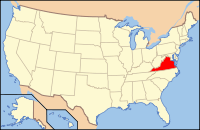Belgian Building
|
Belgian Building | |
.jpg) | |
 | |
| Location | Lombardy St., jct. with Brook Rd., Richmond, Virginia |
|---|---|
| Coordinates | 37°33′06″N 77°27′00″W / 37.55167°N 77.45000°WCoordinates: 37°33′06″N 77°27′00″W / 37.55167°N 77.45000°W |
| Area | less than one acre |
| Built | 1941 |
| Architect | Victor Bourgeois, Léon Stynen |
| Architectural style | International Style |
| Governing body | Private |
| NRHP Reference # |
01000439 [1] |
| VLR # | 127-0173 |
| Significant dates | |
| Added to NRHP | February 26, 1970 |
| Designated VLR | December 2, 1969[2] |
The Belgian Friendship Building or Belgian Pavilion is the former exhibition building for Belgium from the 1939/1940 World's Fair in New York City. It now serves as Barco-Stevens Hall on the campus of Virginia Union University, in Richmond, Virginia.
It was designed by Belgian architects Victor Bourgeois and Léon Stynen under Henry van de Velde, and is notable as an early example of Modernist architecture in the United States. Due to the outbreak of World War II, the Pavilion could not be returned to Belgium. The Belgian government sponsored a competition to determine the building's new home. VUU won, and the Pavilion moved to Richmond in 1941 as VUU's Belgian Friendship Building. Through 1997, the University's library was also located in the Belgian Friendship Building. It is presently VUU's gymnasium. [3]
References
- ↑ "National Register Information System". National Register of Historic Places. National Park Service. 2009-03-13.
- ↑ "Virginia Landmarks Register". Virginia Department of Historic Resources. Retrieved 19 March 2013.
- ↑ "http://www.bellsforpeace.org/belgianPavilion.htm". Bells for Peace Website. Retrieved Mar 03, 2011.
External links
- Belgian Building, Lombardy Street & Brook Road, Richmond, Independent City, VA: 7 photos, 1 color transparency, and 2 photo caption pages at Historic American Buildings Survey

